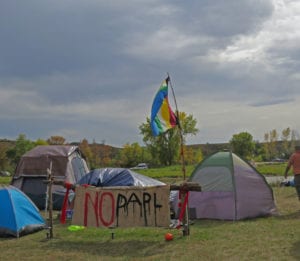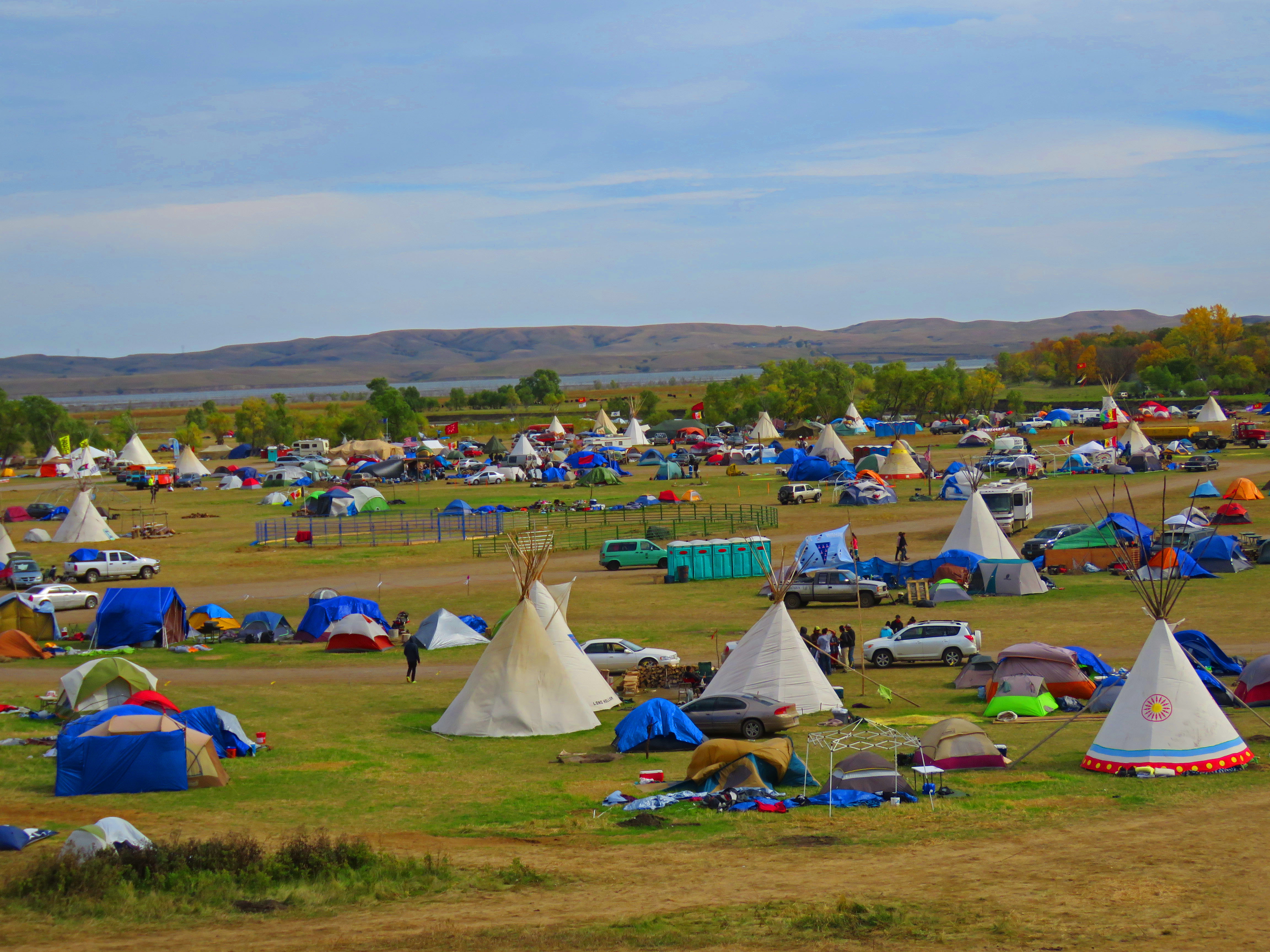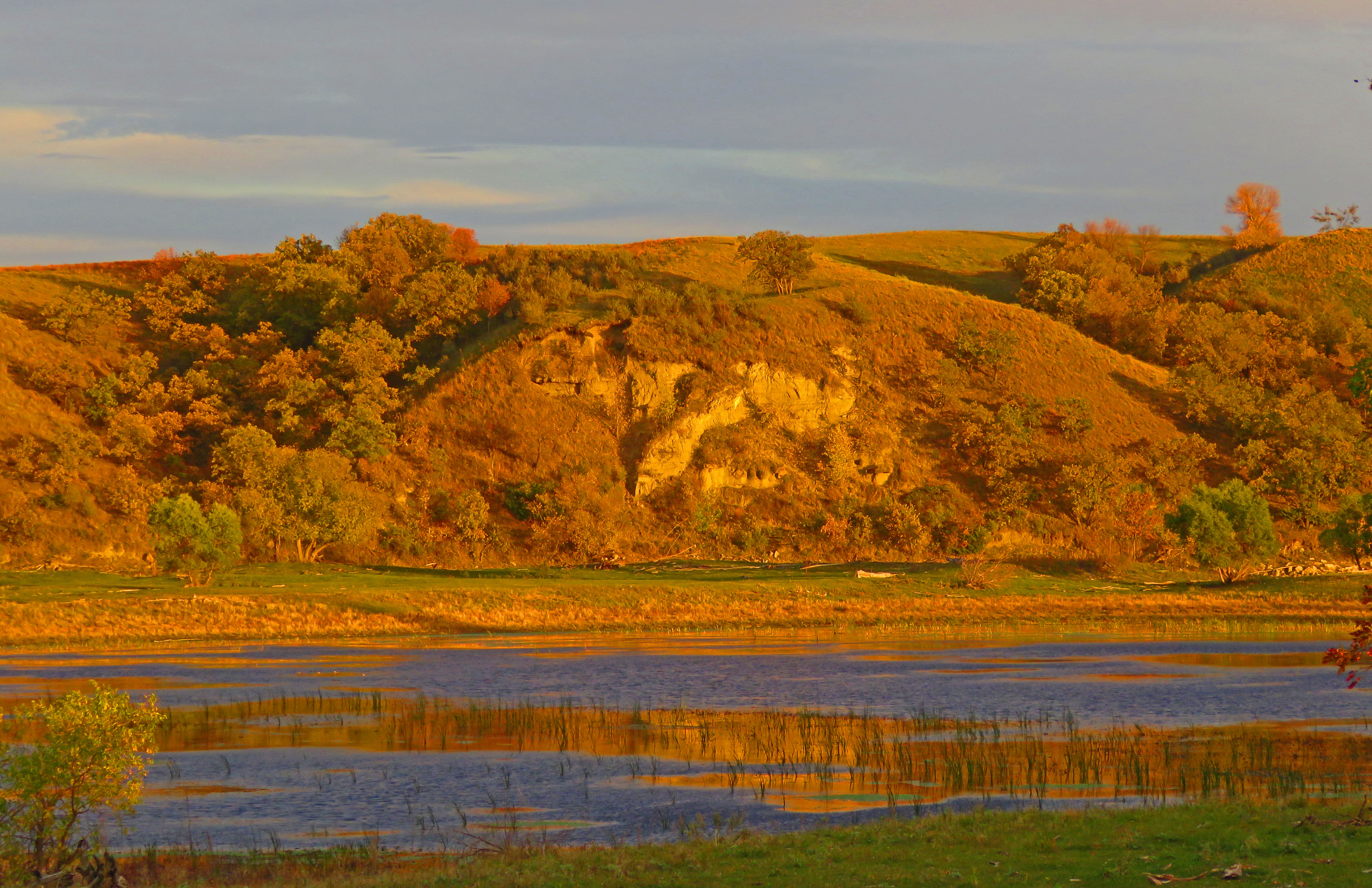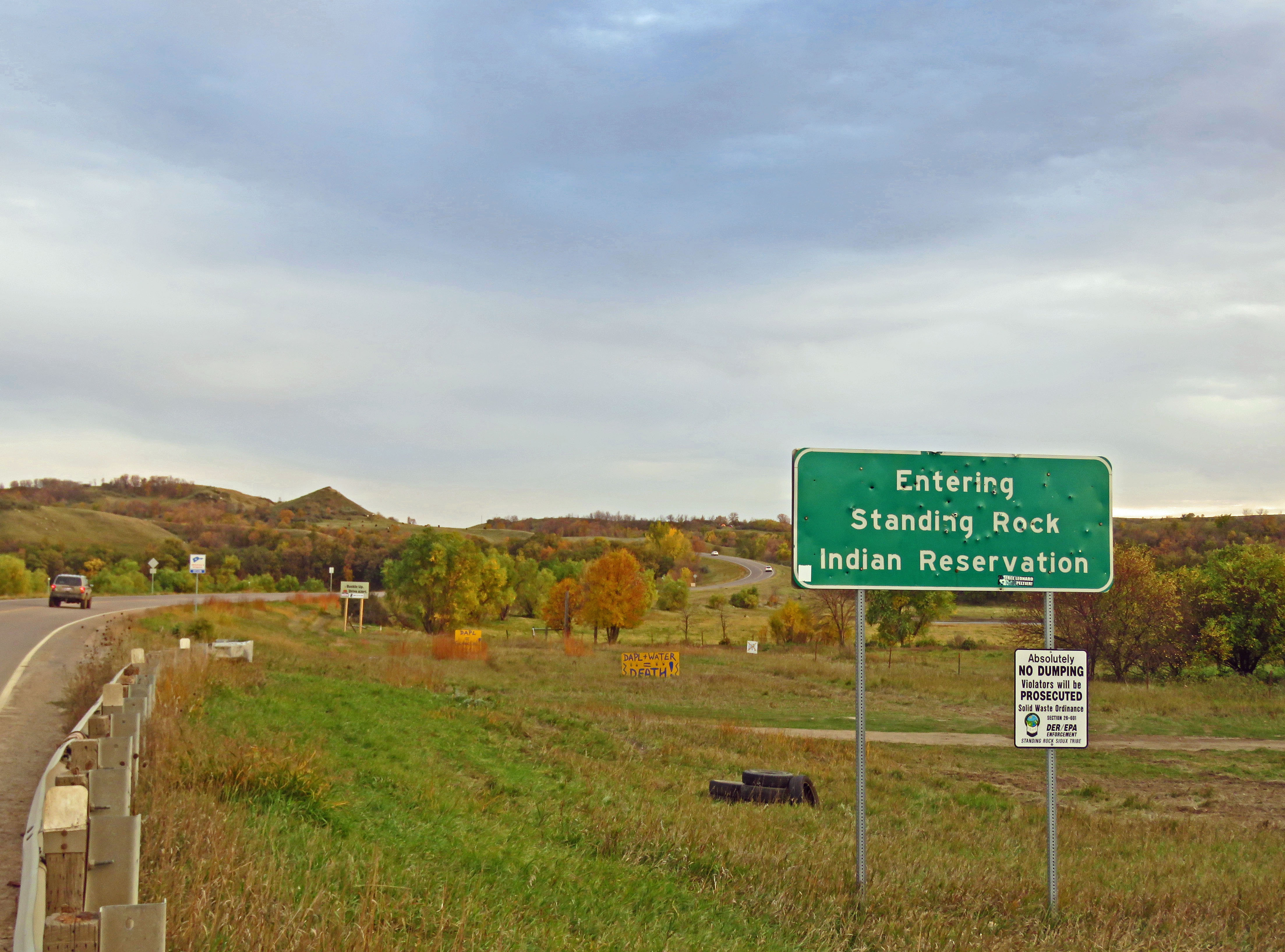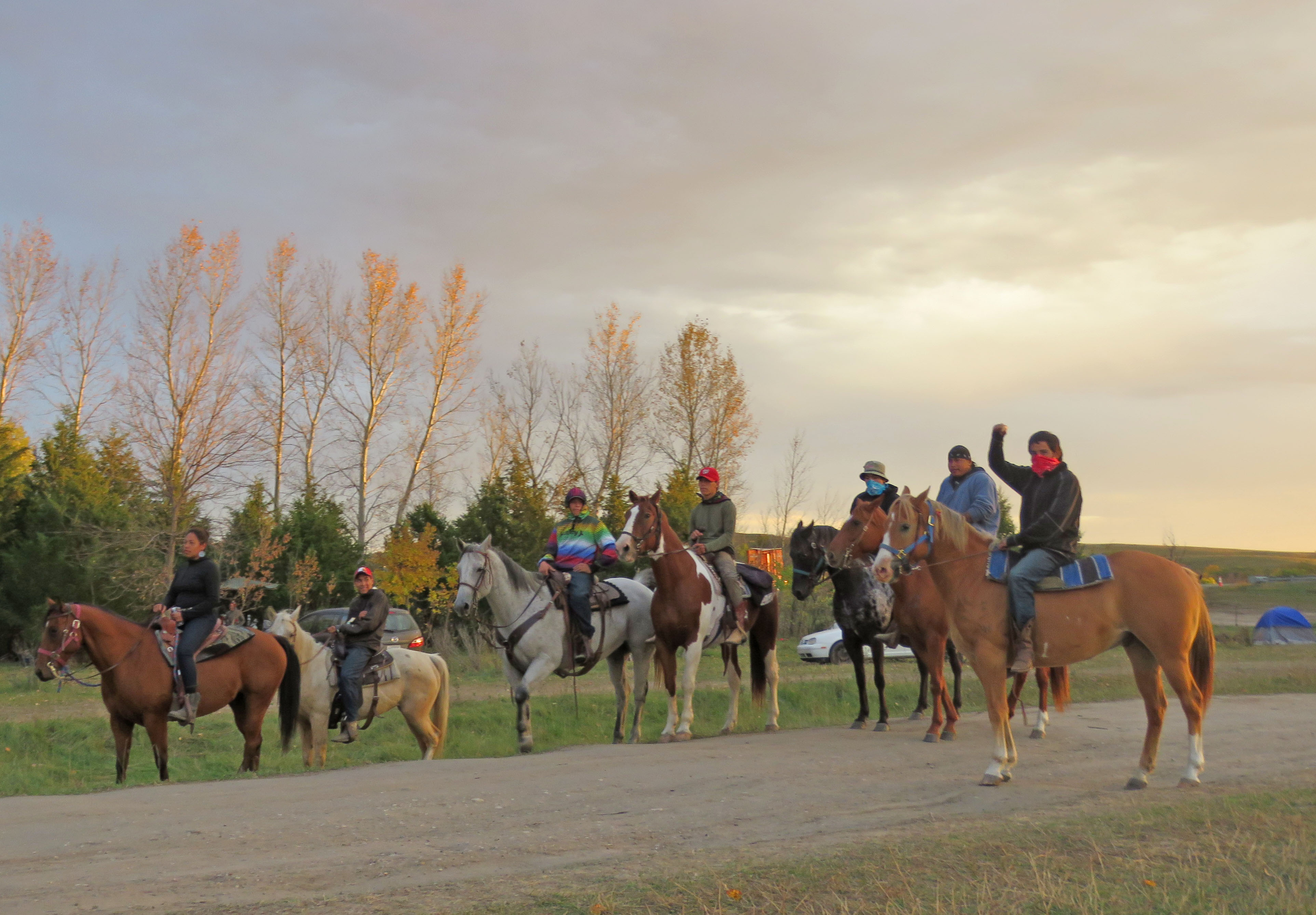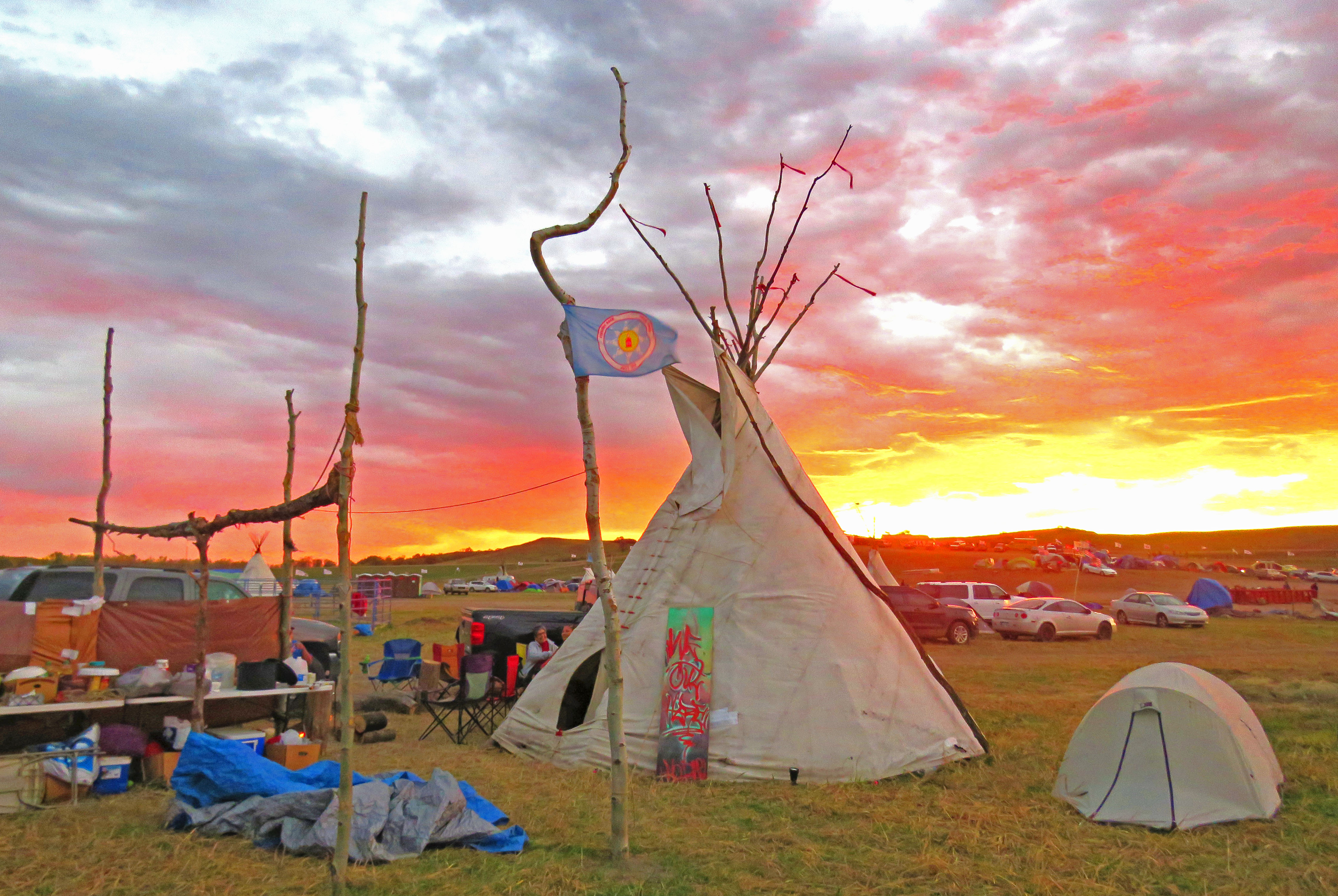
A traditional Sioux teepee at sunrise in the overflow Sacred Stone Camp at Cannon Ball, North Dakota: Walter Simon
By Glynn Wilson –
CANNON BALL, N.D. – Sitting with your legs crossed in a campsite filled with traditional teepees along with modern RVs and tents overlooking the Missouri River here, with the sounds of wolves and coyotes off in the distance, a drum up the hill by the council fire and the occasional Red Warrior whoop, you can feel a little bit of what it must have been like in these lands a few hundred years ago before white Europeans came and committed one of the most egregious acts of genocide in world history.
There is nostalgia and guilt, and a feeling of solidarity with the native people who made their home here long before “white face” arrived. Of course my own genes are mixed with the blood of Cherokee from Alabama and the Scots-Irish who invaded this so-called “new land,” explored by pioneers with names like Lewis and Clark.
When we arrived on Thursday and got to know the people and the place some through Saturday, protests were at a lull. Normal camp life went on with the young Sioux exercising their horses and the cooks making buffalo stew and salmon, donated by tribes from all over the country. There was much talk late into the night about such things as clean water and native rights, and we soaked it all in like tourists allowed a glimpse into a life that barely exists anymore.
Native Americans once numbered about 50 million. Now they are down to about 5 million, not counting those lost through intermarriage, according to some estimates. But they believe they have found what they think is a friend in Washington with President Barack Obama.
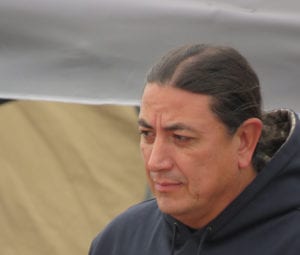
Standing Rock Sioux Chairman Dave Archambault II confers with other members of the Tribal Council: Glynn Wilson
Just back from a whirlwind trip to the United Nations in New York and to lobby the president and Congress in Washington, D.C., Standing Rock Sioux Chairman Dave Archambault II addressed a campfire circle in the overflow Sacred Stone Camp here Friday. He delivered an update to the “protecters” about the latest political efforts to stop the construction of an oil pipeline that has now drawn national attention.
He reported on a letter signed by 19 members of Congress and delivered to the White House Thursday urging the Obama administration to intervene to stop construction of the controversial Dakota Access Pipeline. It is an extension pipeline carrying Baaken shale oil from North Dakota through the Missouri River to Illinois, which runs along the North and South Dakota border just a half a mile from the boundary line of the Standing Rock Sioux Reservation.
The Sioux, protesting what they see as an environmental and cultural threat to their homeland, say an oil spill would permanently contaminate the reservation’s water supply and destroy lands where many of their ancestors are buried.
Archambault thanked Congressman Raúl Grijalva, a Democrat from Arizona, the Ranking Member on the Committee for Natural Resources, for his efforts to rally support from his Democratic colleagues in support of the cause, and said the letter is a demonstration of the “strong support from the United States Congress for protecting our water and honoring our sovereign rights.”
“The U.S Army Corps of Engineers violated the law when it green-lighted construction of the oil pipeline without consulting with the tribe,” Archambault said. “We know it, millions of our supporters agree, and now we have the strength of Congress behind us.”
The two-page letter was a “direct call to action” to an administration that some say has been “the most progressive” in the nation’s history in its efforts to address issues affecting Native Americans, also called the First Tribes. The letter was co-signed by Representative Barbara Lee, a Democrat from California, and Representative Tulsi Gabbard, a Democrat from Hawaii, among the most influential progressive Democrats in Congress.
They urged President Barack Obama to withdraw federal permits for the Dakota Access Pipeline “like you did with the rejection of the Keystone Pipeline.”
“You can and should extend your historic legacy,” the letter stated. “The pipeline poses significant threats to the environment, public health and tribal and human rights.”
The letter came just days after the president addressed the standoff at the White House Tribal Nations Conference made up of more than 300 Indian Nations, where protests of the pipeline have been going on for weeks, and where Mr. Obama expressed some sympathy for their cause, saying they are “making their voices heard.”
The $3.8 billion pipeline, being built to replace two older pipelines, is a 30-inch in diameter pipe that could transport 450,000 to 570,000 barrels of oil a day across four states. It runs from the Bakken oil fields near Stanley, North Dakota to Pakora, Illinois. There it hooks up with other pipelines to transport the oil to the Gulf Coast, where it is used in U.S. refineries such as the Chevron refinery in Pascagoula, Mississippi and exported abroad to places like China and Brazil.
Dallas-based Energy Transfer Partners is financing the pipeline’s construction, claiming it will bring millions of dollars into local economies and create an estimated 8,000 to 12,000 construction jobs. The company denies concerns about any potential contamination, while the Chief Archaeologist of the State Historical Society of North Dakota has launched an investigation into the tribe’s claims that the site contains ancient burial grounds and artifacts.
The company sought a temporary restraining order in U.S. District Court in Des Moines, Iowa, to prevent anti-pipeline activists from interfering with the construction and to require them to remain at least 25 feet away from the route. But a federal judge denied the request.
Protests that resulted in a number of arrests and a violent reaction from private security forces with pepper spray and dogs forced a halt in construction last month after the tribe sued the U.S. Army Corps of Engineers, which claims jurisdiction over the land, arguing that it did not adequately consult with them before granting fast track approval in July. The corps did not oppose the temporary halt in construction.
The tribe issued a statement this week strongly disputing claims that there were no sacred sites contained in the ground destroyed September 3 by the Dakota Access Pipeline.
Everywhere you look driving through this picturesque landscape over the Dakota plains, you see signs saying “No to DAPL.”
While a preliminary internal memo from the State Historical Society of North Dakota states there were no human remains or significant sites found in the construction zone, that is still in dispute.
“It is my understanding that the Chief Archaeologist of the State Historical Society of North Dakota, has an ongoing investigation regarding the destruction of important cultural resources and gravesites along a portion of the path of the Dakota Access Pipeline near the Standing Rock Sioux Reservation,” said Jon Eagle Sr., the Standing Rock Sioux’s Tribal Historic Preservation Officer. “That investigation has not been completed, so any reports regarding the conclusions of the state’s investigation are premature.”
He said the Tribe provided vitally important documentation on September 2 about a number of sacred sites, including stone features and burials, along a two mile stretch in the pipeline’s path. The following day, Dakota Access sent construction crews to that specific place, and “bulldozed the entire area,” Eagle said. “This terrible and intentional action was taken without consulting with tribal or state historic preservation officials. The tribe has strongly objected to this desecration of our sacred sites. And we have called on the State Historical Society of North Dakota to take appropriate action to issue a stop work order to prevent additional harm to sites.”
The tribe is not alone in its effort to see that the destruction of its sacred sites is properly addressed. In a letter to President Obama, and the Departments of Justice, Interior and Army, more than 1,200 archaeologists and other professionals have wieghed in.
“As archaeologists, anthropologists, historians, and museum workers committed to responsible stewardship, we are invested in the preservation and interpretation of archaeological and cultural heritage for the common good,” the group said in the letter. “We join the Standing Rock Sioux Tribe in denouncing the recent destruction of ancient burial sites, places of prayer and other significant cultural artifacts sacred to the Lakota and Dakota people.”
Under Section 106 of the Review Process in The National Historic Preservation Act, Section 101(d)(6)(B), federal agencies are required to consult with any Indian tribe that attaches religious and cultural significance to historic properties that may be affected.
“The tribe has particular expertise in the identification and protection of sites that are important to the tribe’s own culture,” Eagle said. “For this reason, it is important for the state’s chief archaeologist to consult with my office and to conduct a joint comprehensive review on the ground. I am confident that if the chief archaeologist is willing to work together in this way, that will lead to a fair decision that will recognize and protect our sacred sites.”
Tim Mentz Sr., a Traditional Cultural Specialist and consultant with Makoche Wowapi LLC, which is dedicated to the identification and protection of Dakota and Lakota cultural heritage sites, said his team surveyed the land in question and noted rare and significant sites.
“Archaeologists don’t see these things,” he said. “People from the state Historical Society just walked right past those, because they don’t have the connection that we have to this land and to our history and stories.”
The tribe also disputes DAPL’s claims regarding sacred sites. There are currently two different maps outlining the locations of historical artifacts: one produced by DAPL and one produced by the tribe. At issue, says the tribe, is that DAPL has provided no indication of where its data came from or identified the cultural experts who contributed to the map.
“We think it is important to set the record straight on the many false claims being made in regards to our sacred places,” Mentz said. “In court filings, DAPL claims that its own workers identified no sacred sites within the work area. It is outrageous to suggest that a construction crew can conduct an assessment of this type.”
Business leaders and construction unions have lined up in support of the pipeline project in Iowa and other states, according to local reporting, citing economic benefits and a desire for U.S. energy security. The push for completion of the pipeline comes as many major fossil fuel projects across the U.S. have been shelved or significantly delayed because of new regulations, grassroots opposition and a decline in energy prices. More than a dozen projects, worth about $33 billion, have either been rejected by regulators or withdrawn since 2012, according to news reports.
The Dakota Access pipeline still faces a trial in December on a lawsuit from property owners who object to the use of eminent domain to secure access to farmland for the project, and a legal challenge from the Iowa chapter of the Sierra Club, which contends the Iowa Utilities Board erred in granting approval. A decision on the eminent issue could ultimately be decided by the Iowa Supreme Court.
A federal appeals court ruled to officially halt the construction of the pipeline September 16 to give the court more time to assess concerns that the pipeline could destroy sacred sites. A federal judge is expected to rule on the pipeline’s fate on Oct. 11.
Meanwhile in the original Sacred Stone Camp and the other three camps near the site of the pipeline, there is a feeling that protests and political action must continue to stop it at all costs. While people in other places, such as Mobile, Alabama, have lost battle after battle with Big Oil and state and local governments over storing and transporting fossil fuels, there is a larger battle to save the planet at work with spiritual as well as practical implications.
On the way through the high fructose corn syrup fields in Missouri, Iowa and Nebraska to get to this remote location, you pass at least one wind farm with tall, white wind mills in stark contrast to the blue sky. They say the wind likes to blow about 30 mph around here, and while it is a dangerous place to pump oil underground, it is the perfect location for generating wind energy.
Think about it.
While this protest has generated wide spread attention and won some battles with action from federal courts and the administration in Washington, unless humans all over the world begin to make the transition to alternative energy, the Sioux may be fighting a winning battle in a losing war, like Sitting Bull and Crazy Horse back in the day. According to all the best information from scientists the world over, climate change is upon us and will not only result in environmental devastation. It will destroy economies and cultures too.
More Photos

Main Street through the overflow Sacred Stone Camp with the flags of more than 300 tribes: Glynn Wilson
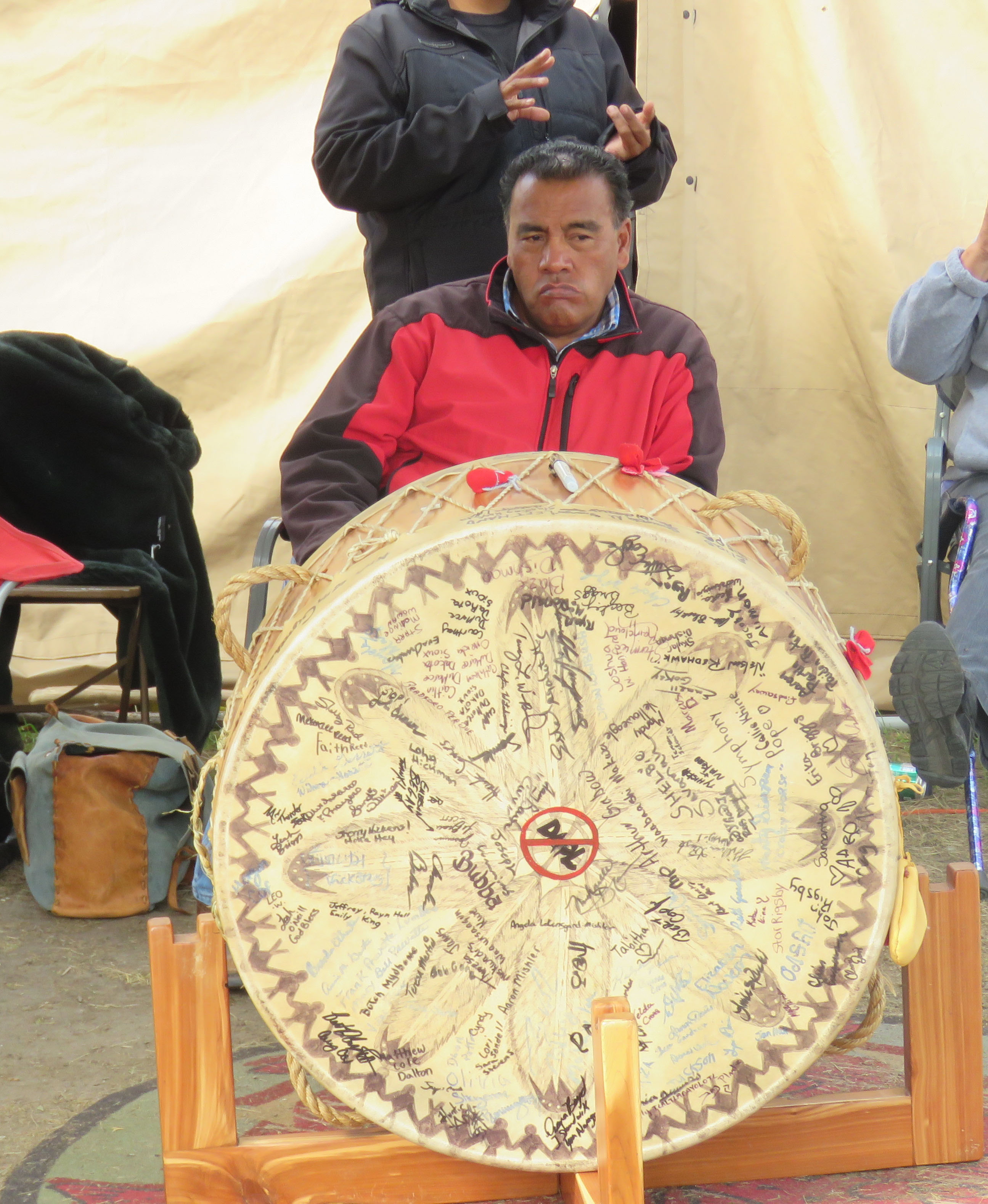
A member of the Standing Rock Sioux Tribe watches over a cerimonial drum donated by a tribe in Tennessee: Glynn Wilson

Standing Rock Sioux Chairman Dave Archambault II (right) confers with other members of the Tribal Council: Glynn Wilson

Standing Rock Sioux Chairman Dave Archambault II welcomes a delegation from North Carolina: Glynn Wilson


